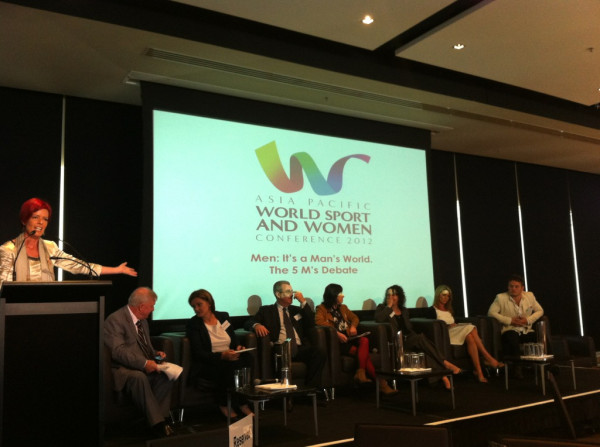Here are my notes from Day 1 on the Asia Pacific World Sport and Women conference held at the MCG yesterday.
Day 1 – Monday 8th October 2012
WELCOME and Official OPENING
Her Excellency, Ms Quentin Bryce AC CVO, Governor-General of the Commonwealth of Australia
Sports Geek notes
Firstly congratulations to the Australian Women’s T20 Cricket team the Southern Stars winning the World T20 tournament last night despite being 8 pages in from back page in today’s paper.
“Women’s sport matters a great deal to me”, Bryce said. Told story of her childhood in the bush & how much sport played a part of her growing up. In the 50s the Australian sports scenes was filled with sports heroines, important and influential in their lives.
Encourage and support are important for children to continue sport into their teens, parents & schools play a key role as do great role models currently in Australian Sally Pearson, Anna Meares & Lauren Jackson to name a few. We need these role models in the media to inspire girls to follow their lead.
In 1984 the Sex Discrimination Act opened the door that brought change that delivered opportunities in sports to women as clubs offered full memberships to women in sports clubs.
Women’s sport still needs more coverage from the media with under 10% sports media coverage dedicated to women’s sport.
MONEY – Setting the Scene
The Economic and Social benefits of increased female involvement in the Business of Sport How will Demographic Analysis, Market Assessment, Masterforce and Workforce Planning impact on the future business of Sport? ?Learn how canvassing census and other data to determine lifestyle trends can be used to identify development and investment opportunities in the ‘Sports' environment. Identify ‘growth' opportunities and be surprised by how easy it is to make decisions based on an assessment of demographic trends. Hear what is being done with the 18 recommendations that came from 2006 Senate Inquiry into Women in Sport that addressed the need for more support for women's sport and recreation in Australia, particularly in the critical role media plays in neglecting women's sporting achievements.
Bernard Salt, Demographer, KPMG
Senator Kate Lundy, Federal Minister for Sport
Sports Geek notes
The Demographics of Women in Sport: Where gains can be made – Bernard Salt
Starts by looking at the tribes – Fusion Culture – English & New Zealand & Asia & India
Stronger increase in Indian population 100% increase last 5 years compare to 6% in British.
Metropolitan Australia is
Some acronyms:
PUMCINS – Professional Urban Middle Class In Nice Suburbs
NETTELS – Not Enough Time To Enjoy Life
KIPPERS – Kids in Parents Pockets eroding retirement savings
LOMBARDs – Lots of money but are real dickheads
Sporting focus next ten years
- Rising market – 5-15 market
- Sports in schools
- Heroes & icons
- Young adults
- Team sports
- Social Networking
- Childminding
- Mature Adults
- Coaches
- Commentators
- Sponsors
- Active Retirees
- Volunteers
- Umpires
- Supporter
In 1932 average age was 63, people were “old” at 50. Teens did not exist.
In 1972 average age was 71, people were “old” at 60. Teen market developed.
in 2012 average age in 82, Adolescence from 12-30, Adult 30-55, Lifestyle 55-65, Retired 65-75, Old 75+.
Top sporting activities
- Walking
- Aerobics
- Swimming
- Cycling
- Running
- Golf
Sport is one leisure activity but others are on the rise
- Computer games 404%
- National Parks 200%
- Music Concerts 163%
- Golf Equipment 124%
- Televisions 124%
- Camping Equipment 109%
- Health clubs 88%
- Eating out 68%
- Alcohol 65%
- Sports lessons 52%
Demographics implications for women in sport
- Women are severely under represented in professional sports occupations, Australia women need role models.
- Australia’s ethnic mix is changing from Anglo-Mediterranean to Anglo-Mediterranean-Asian Fusion.
- Ageing of the population creates opportunities for new sporting leisure pursuits & volunteering roles.
- Modern lifestyles flex and shuttle at different stages of the life cycles.
Kate Lundy, Minister for Sport
“About Time” report – http://www.wwda.org.au/sportfr06.pdf
Social Media at times a challenging environment but a tremendous opportunity for sports.
Great for sports for AFL & NRL securing $1BN in TV deals but TV networks still “try it on” with with women’s sport asking for production costs to cover women’s sport.
Gender equality must start in the boardrooms of sport. Target is 40% for women on boards.
Announcement: Government to support Women in Sport scholarship in 2013
It's a Man's World – The 5 ‘M’s Debate
Facilitated discussion to set the cat amongst the pigeons right from the start on what men really think about women, sport, women in the business of sport and women's sport.
This discussion promises to be a talk-tickler, controversial and exciting. In the song – it's not only a man's world, it's a man's man's man's world – so is that what the world of sport is all about? Is Sport dominated by too many men? Where do women get to make the decisions? Are the male decisions makers in politics and business, and who dominate the boards of many sports, both professional and otherwise, giving the girls a fair go? Are the right girls getting the gigs? Why should Black Caviar get better billing than any human female athlete performing on the world stage?
Who says “people” don't want to watch or read about women's sport? Who determined that the public won't choose to pay to see women play sport at an elite level?
Why is it that nowhere other than at the Olympic Games, and the odd world championship, that women's sport doesn't matter?
And finally if sex sells then….?
This session will ask the hard questions to get the answers from the people who have views on these and many other matters. No political correctness allowed at this conference busting opener. Get The top 5 tips from our panelists on how to break down the barriers and how to get ‘YES' for an answer.
Sam Bramham, OAM, Australian Paralympian, ?Disability Sport & Recreation Ambassador
Geoffrey Lord, Chairman & CEO, Belgravia Group
Tom Maher, Head Coach, WNBL Bulleen Boomers Basketball Team, Great Britain Women's Basketball Team
Bonita Mersiades, Strategy and Communications Consultant; Writer / Analyst
Kim Morrison, Author, Speaker, Health & Lifestyle Educator, World Record Holder, Business Woman, Wife and Mum
Chelsea Roffey, Goal Umpire, AFL
Jane Russo, Board Director, Touch Football Australia
Sports Geek notes
Bonita Mersiades – If politicians think it’s tough for women in politics they don’t realise how hard it is in male dominated sports industry. Low representation of women on boards is not good enough!
Tom Maher – Looking back the powerhouse that was the Nunawading Spectres in the 80s with Michelle Timms & Robyn Maher leading the way. More community work by team didn’t lead to bigger crowds but was let down by poor opposition & lack of professionalism by the league overall. It all comes down to developing an appealing product for fans requires commitment by all parties. Organising bodies need to think about whole picture, as an example FIBA extended 3-point line without thinking about the grass roots & junior competitions.
Kim Morrison – Men are quite easy to work with when you use your female charm. Stand with volition & conviction. “Mike Atherton caught by short & girlys” was the headline when he was caught by a women in cricket match organised by Kim. Message from Natalie Cook “Speak out with volition & conviction and doing it more often” From Kim, “You need to be the greatest role model you can be”.
Geoff Lord – Already shaking my head about the obsession with women in sport. At Belgravia we employ over 5000 people and a majority of them are women. Stop talking about it & start doing it, positions should be awarded on merit so get on with it!
Sam Bramham – Women in sports do face inequality, some of these are due to misconceptions in sport which are slowly being broken down.
Chelsea Roffey – Sex sells but not un umpiring the uniform is horrible. The AFL Grand Final week was a circus. Pushes herself harder to dismiss notions of “token female”.
Jane Russo – Women are good for business, companies with women on boards perform financially better. Always bring your true self, most important you are on the board for your talents not your gender.
THE 5 M’S – The Good. The Bad. And the Ugly
 Case studies. ‘The Good. The Bad. And The Ugly' – what works and what doesn't; the business end and highs and lows of delivering world class sporting events and competitions. How our experts have tapped into the female market.
Case studies. ‘The Good. The Bad. And The Ugly' – what works and what doesn't; the business end and highs and lows of delivering world class sporting events and competitions. How our experts have tapped into the female market.
Objective commentators on which strategies work when the business of sport applies the 5m's – Money. Members. Media. Marketing and Men. When the 5 ‘M's' Work its magic so how can your organisation replicate the process for success?
This panel session looks at the successes and near misses of women's sporting teams and events from the perspectives of those who run the organisations which run the events, the sponsors and supporters of those events and those who comment in the media about those events.
Lynne Anderson, Managing Director Australia and New Zealand, Repucom
Michael Brown, CEO, AFC Asian Cup Australia 2015
Eugenie Buckley, Principal, Suiko Consulting
Neil Dalrymple, CEO, Bowls Australia
Catherine Ordway, Lawyer, Anti-Doping Consultant
Sonya Ottaway, President, Netball America
Sports Geek notes
Lynne Anderson – Brought marketing & business rigour to the world of sports when starting out at the Canterbury Bulldogs. Rugby League had easy money from tobacco & leagues clubs revenue when Lynne started at the Bulldogs & crowds trending down. Research was key to back up your judgement.
Two key points came out from Bulldogs research:
- cultural shift of area – multicultural days were very successful in attracting new fans.
- 20% of attendees were women – how to engage & make it family friendly.
- Opened Wine Bar
- More Family facilities
- Activities for children
- Sponsored local netball clubs
Treat your business as you would any other business.
Super League drama was a big learning experience, money spent poorly & wasted in that era.
“It's more about the fan now more than ever.” final point from Lynne.
Michael Brown – Good to see the story about the Southern Stars was a little bigger than the demise of the Men’s T20, small steps.
One thing we all have in common we all start playing at community level, it is why it is so important.
“Build it & they will come”, doesn’t necessarily apply it is a tough commercial market. You need to be smart, articulate in your efforts to succeed.
How do we build communities? Inclusion is important, cricket has grown female audience via grassroots programmes & marketing initiatives with Big Bash Leagues.
Do you know who your fans are? Do you know want they want?
Understand your stakeholders.
Eugenie Buckley – More opportunities for women thanks to U20 & U17 World Cup as well as the developing W League. Athletes won’t let you down, look at Elyse Perry hitting a six at the MCG, double headers have worked well for Matildas & Southern Stars. Rugby 7s is another developing sport attracting premier women athletes.
Cricket NSW do a great job integrating the women’s team in what they do.
Neil Dalrymple – Growing participation but dwindling membership, that is the key problem.
Introducing colour has helped to change perception of bowls.
Changing the time of bowl competitions has been key as people’s time needs have changed.
Catherine Ordway – Good sport on field is supported by good support off field in governance & leadership.
Women on Boards initiative has grown to have 11,000 women ready to be on boards but still no structures available to get on boards – No vacancy sign up on board rooms.
Sonya Ottaway – People are the key, biggest lesson in sports business life.
Obese is the national security issue for the US, fat kids can’t help Defense force.
President’s Challenge programme has been critical as part of “Let’s Move” initiative.
Join the Club: Why Members Matter -People & Culture
Learn how organisations that have shifted the culture and included greater diversity in thinking have generated more participants in club, school and community activities. Increased membership, increased spectator numbers, a boost in sponsorship revenue, and a more welcoming environment for children and families are just some of the benefits that come with changing your organisation's attitude as a result of greater female inclusion. Can your organisation afford to procrastinate in this ever-changing and competitive recreation and leisure environment? Learn what turns volunteers on to your sport and how you can capitalise on this massive human resource.
Sean Callanan, Sports Geek
Sue Clark, Cultural Strategy and Education Manager
Susan Crow, General Manager Community, Melbourne Heart FC
Jude Maguire, CEO, School Sport Victoria Department of Education and Early Childhood Development
Heather Reid, CEO, Capital Football and Canberra United
Cameron Schwab, CEO, Melbourne Football Club
Sports Geek notes
Here are the 5 top tips from the panel members
Heather Reid
1. Identify potential members
2. Find out what they want
3. Tailor programs to meet needs
4. Don’t assume everyone wants the same outcome
5. Recognise & reward members
Susan Crow
1. Be authentic
2. Be welcoming & inclusive
3. Provide, fun, social opportunities for girls
4. Use female role models
5. Ensure supporters & their families feel safe
Jude Maguire
1. Understand local community needs
2. Empower young people to lead
3. Value partnerships to strengthen the programmes
4. Ensure the community sense ownership and contributes
5. Value diversity & reward volunteers
Sue Clark
1. Inclusion – make it a priority
2. Social Leadership – understand the responsibility
3. Investment – people are your greatest asset
4. Change – it takes time
5. Values – understand what you value
Brendan Schwab
1. Understand purpose – deeper meaning
2. Why do people align their identity to your club
3. Build the narrative based on these insights
4. Understand the narrative – particular your own people
5. Communicate well, with consistency and often
Sean Callanan
1. Understand the platforms you are using and how your fans use them
2. Always be training your fans
3. Social Media is about storytelling not broadcasting
4. Don’t ignore customer service on social media
5. Don’t piss off your fans




